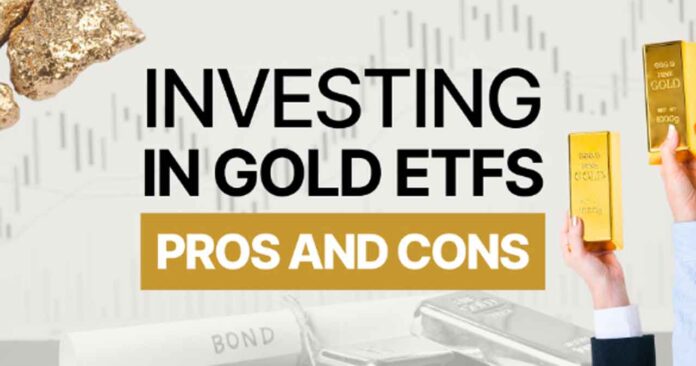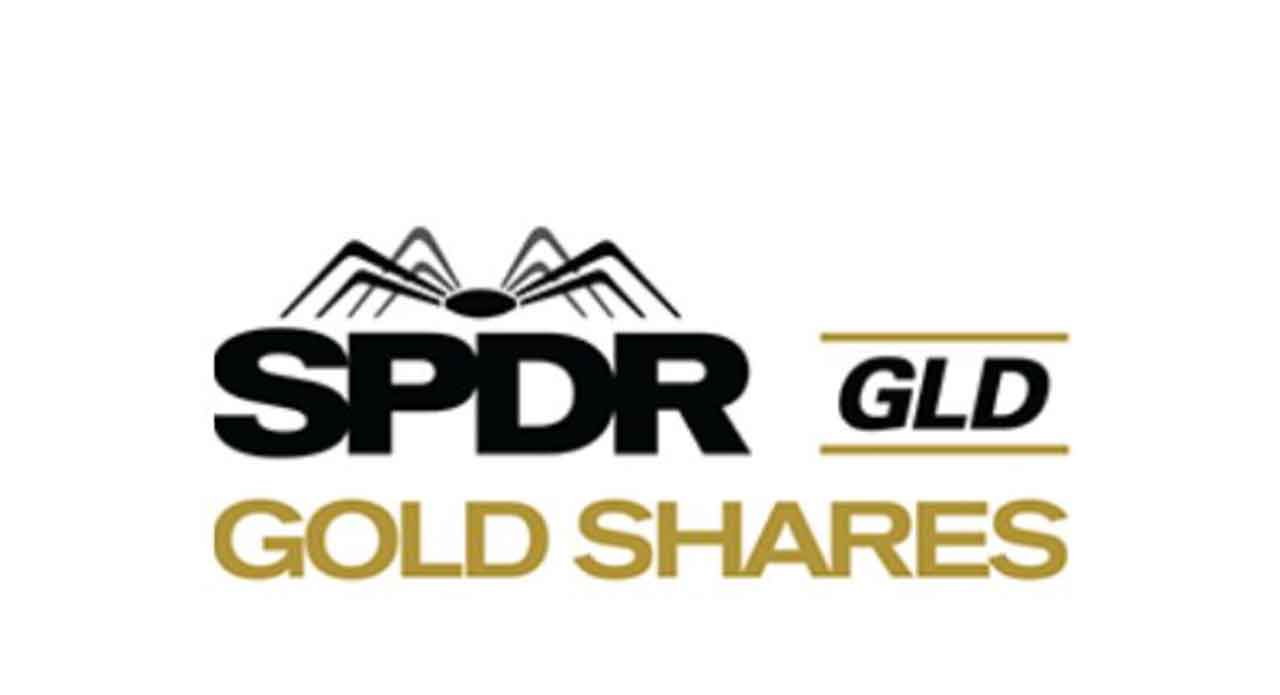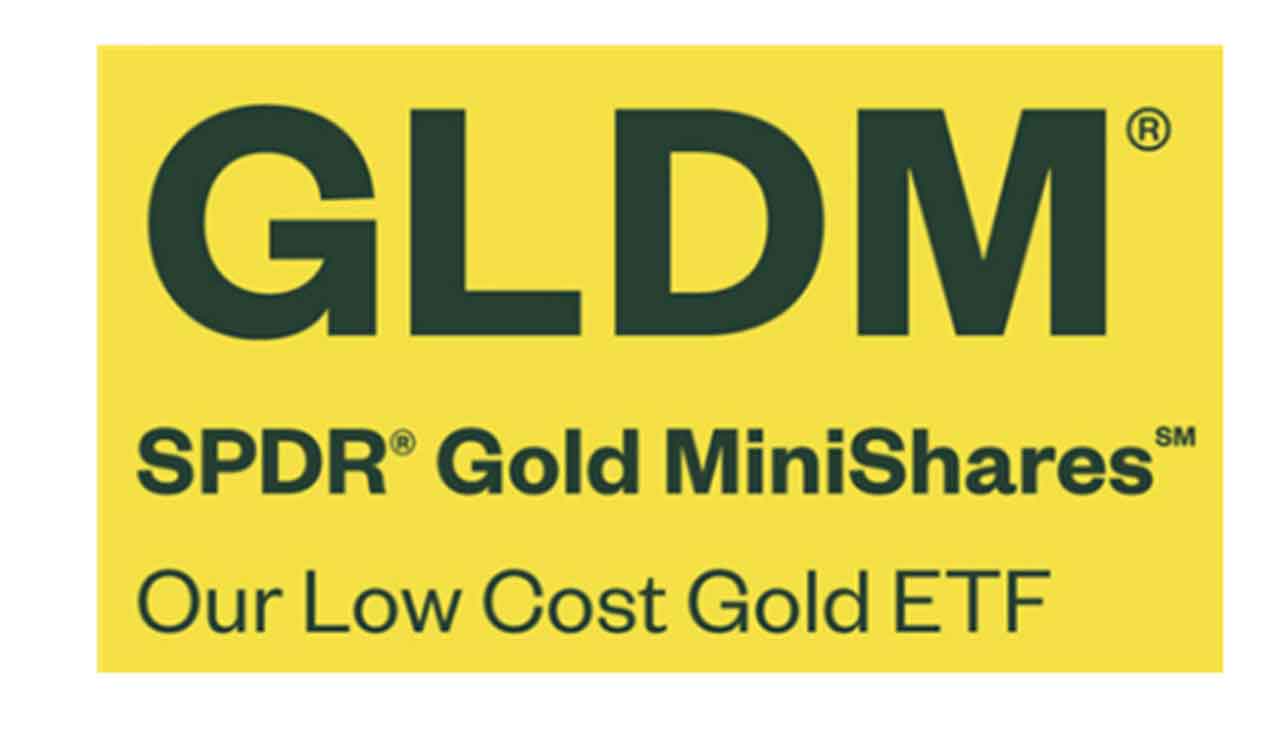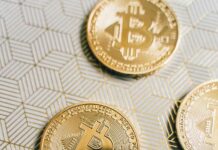
Investors often turn to gold as a way to safeguard their investments against inflation. While direct investment in gold can be made through purchasing bullion like gold coins or bars, additional expenses such as storage fees, dealer commissions, insurance, and security must be factored in and can accumulate rapidly.
Investing in gold ETFs is a popular and cost-effective approach that provides an alternative to investing in physical gold. Gold ETFs allow investors to invest in a fund that tracks the price of gold without owning any physical gold. We found that SPDR Gold Trust was the ETF with the most favorable conditions.
When compared to investing in gold mining companies or trading gold futures, gold ETFs can be a more cost-effective and easily accessible choice due to their high liquidity. This article will delve into the world of gold ETFs, providing an explanation of their nature, how they function, and tips on how to start trading them.
What are Gold ETFs?
An ETF (exchange-traded fund) is a collection of securities that seeks to follow a specific asset, industry, or economy. Instead of concentrating on a single type of investment, an ETF provides exposure to various underlying securities.
ETFs are financial products that follow a particular index, commodity, or asset rather than a particular company. These ETFs are bought and sold on stock exchanges, just like company shares.
Gold ETFs are investment funds that aim to mirror the progress of gold. They can attain this goal by buying the actual metal or by trading in financial instruments that are associated with gold, including futures contracts or stocks of companies involved in the gold sector. It’s not necessary for these funds to invest solely in the physical commodity.
Traders choose to invest in a fund that reduces the expenses and hassles of owning physical gold while also reducing the risk in their investment portfolios. As the value of gold has a weak connection with the value of the US dollar, investing in gold is a wise move to protect against fluctuations in other unstable assets.
Investment strategies differ across different funds and could involve investing in a range of financial instruments.
ETFs are an example of a fund that solely tracks the spot price of gold by backing it up with physical gold, such as bars, coins, or bullion, which are kept safe in secure vaults for investors. The value of each share in the ETF is equivalent to an equal share of one ounce of the fund’s gold.
Read more: Best Gold IRA Companies
Advantages of Investing in Gold ETFs
Gold ETFs provide an opportunity for novice investors to invest in and monitor the performance of gold, whether they wish to track the spot price, a particular sector, or the gold mining industry.
Gold is a widely favored asset for investors seeking a “safe haven” investment, but not all investors want to bear the expenses associated with owning physical gold. ETFs are generally less risky and less expensive than actively managed funds.
Investing in a Gold ETF has several benefits that should not be overlooked:
Lower Fees
Gold ETFs are less expensive compared to actively managed funds as they only need passive management.
They have expense ratios as low as 10% for a $10,000 investment, and some ETFs offer commission-free trading for gold. The cost of owning physical assets like gold can be quite high due to storage, commissions, security, and other fees.
Portfolio Diversification
Gold ETFs offer exposure to the gold industry, either through a commodity or a group of equities. These investment options are particularly useful for investors looking to diversify their portfolios, especially those who are vulnerable to economic downturns.
Even if you’re not interested in owning physical gold or lack the resources to do so, you can still benefit from monitoring gold prices through an ETF. Find out more about the best gold ETFs for diversification.
Reinvested Dividends
To prevent dividend drag, many gold ETFs reinvest the dividends right away, which allows the fund’s investors to increase their returns over time by earning more shares and receiving more dividends that are automatically reinvested.
Fluidity
Due to the fact that gold ETFs are traded on the stock market like regular stocks, they’re known to be very flexible and highly liquid. This means that buying and selling ETFs does not require high overhead fees or any administrative requirements
On the other hand, selling physical gold can be more challenging due to the varying liquidity depending on the type of bullion owned. Coins are easier to sell due to their collectability, while bars or rounds may be harder to find buyers for.
Minimal Overhead
When it comes to investing in gold, owning gold ETF shares has fewer overhead fees than owning physical gold, which requires significant costs such as transportation, insurance, commissions, storage, and handling.
Opting for gold ETFs can be a cost-effective option for investing in gold compared to purchasing physical gold or investing in an actively managed account. This is especially beneficial for long-term investors due to the absence of administrative costs.
Small Denomination
A major benefit of investing in gold ETFs is that they offer the option to buy them in small units.
Each unit of gold ETF shares represents one gram of gold, which makes it possible for investors to add gold to their investment portfolio without the expenses associated with buying gold bullion.
Hedge Against Inflation
During uncertain economic situations, investors often seek to protect their assets by investing in physical gold, which typically retains its value and may even increase in value when the dollar decreases in value.
However, some investors are not interested in the hassle and expense of managing pure gold, so they may choose to invest in gold ETFs instead.
Gold ETFs function by monitoring the existing market value of gold and therefore offer the same level of returns and risk-aversion advantages as possessing physical gold. Instead of handling bullion, the process of investing in gold is akin to purchasing traditional stocks. Inflation and deflation regarding cryptocurrency may mean something different.
Discounts or Lower Premiums
During market hours, several ETFs display their intraday net asset value. As ETFs are traded throughout the day at prices that closely match the actual worth of the underlying securities, the variances in discounts or premiums are negligible, and arbitrage ensures that any price discrepancies are corrected.
Nevertheless, due to differences in time zones, international ETFs may have either lower or higher discounts or premiums.
Limited Capital Gains Tax
In most cases, individuals are required to pay taxes on their capital gains, which may vary depending on their income. Besides, purchasing physical gold involves additional taxes such as sales tax, VAT, and wealth tax. Nevertheless, Gold ETFs are more tax-efficient as they have fewer taxable events.
Investors can delay paying taxes until they sell their ETFs, which enables them to manage their tax planning more efficiently. Other forms of investment, like cryptocurrency, may have more complicated taxes. Learn more about taxes on cryptocurrency.
Similarities To a Stock
ETFs are traded on an exchange, just like stocks. Each ETF has a unique symbol that you can use to check its daily price, and its shares are as easily traded as stocks.
Additionally, the same trading strategies used for stocks, such as margin trading, short selling, and trading options and futures, can be applied to ETFs with real-time pricing.
Disadvantages of Investing in Gold ETFs
ETFs, like any other investment, have their drawbacks. Although they’re a secure investment, their returns may not be as significant as those of other assets.
One must be cautious when purchasing an ETF without conducting proper research, as some ETFs are hazardous and are more appropriate for experienced investors. Investing in a gold ETF has some disadvantages, which are as follows:
Risk
Gold ETFs are often regarded as low-risk investments by investors, but they carry comparable risks to stocks. These ETFs are traded on derivative markets with intraday pricing, which may result in losses for long-term investors who engage in reactionary trading. However, end-of-day pricing provides protection against impulsive trades.
Wide Range of Options
As a new investor looking to invest in gold ETFs, you may find yourself overwhelmed by the numerous options available.
With a diverse range of ETFs holding various securities in different sectors, it can be challenging to determine the most suitable gold ETF to meet your investment needs.
Potentially Higher Costs
Investing in a gold ETF may be less expensive compared to owning physical gold due to lower overhead costs, but it can turn out to be pricier than equity investment. The charges incurred while buying stocks, such as broker’s commission, are also applicable in gold ETF investment, along with management fees.
Additionally, you need to pay an annual expense ratio, which is a specific percentage of your investment.
Associated Fees
Like other investment options, gold ETFs also come with fees that include expense ratio and commission charges for buying or selling shares. It’s important for both active traders and long-term investors to consider these costs while devising their investment plans. Nevertheless, a few gold ETFs provide the facility of commission-free trading.
Inability To Redeem for Physical Gold
Investors who hold a Gold ETF account cannot exchange their shares for physical gold. This is because the investment made in a gold ETF involves purchasing gold-backed contracts rather than the actual commodity.
While it’s possible to sell the shares, doing so defeats the purpose of using the ETF as a safeguard against economic events and inflation.
Lower Dividend Yields
Investing in high-risk stocks can lead to significant gains, while ETFs offer a low-risk option. Gold ETFs have a smaller yield than average because they follow a larger market. Selecting individual stocks enables you to choose the highest-yield dividend from an equity.
Leverage Returns That Are Skewed
ETFs that are leveraged may seem appealing due to the potential to increase returns by two or three times. Nevertheless, losses can also increase rapidly in a brief period. The more time you keep the ETF shares, the more diverse the overall return of the underlying asset will be. Investing in cryptocurrency also has pros and cons.
The Most Popular Gold ETFs
Some of the widely preferred gold ETFs across the globe are listed below:
SPDR Gold Shares – GLD

The SPDR Gold Shares ETF is the leading gold ETF in terms of size and liquidity. It was introduced on the New York Stock Exchange in 2004 and presently stores 32 million ounces of gold bullion in the HSBC vault located in London.
The Exchange-Traded Fund (ETF) currently manages assets worth $55.6 billion and provides partial ownership of the trust’s gold through its shares.
If you want to invest in gold without buying and storing actual bullion, you can purchase shares of SPDR Gold Shares on a stock exchange. Investing in GLD will give you exposure to gold’s spot price. The expense ratio for GLD is 0.40%, which means a $10,000 investment will incur a fee of about $40.
SPDR Gold Minishares – GLDM

For long-term investors, SPDR Gold MiniShares might be a better investment option than GLD. By investing in SPDR Gold MiniShares, traders can still have ownership of physical gold bullion but with a lower expense ratio, price per share, and bid-ask spread compared to GLD. It’s advisable for buy-and-hold investors to consider this option.
GLDM is a gold ETF option that is ideal for both new investors and those seeking long-term growth. It has an extremely low expense ratio of just 0.10%, which equates to a cost of $10 for a $10,000 investment.
iShares Gold Trust – IAU

The IAU ETF, also known as the iShares Gold Trust, is a moderate alternative to GLD and GLDM. It follows the LBMA to provide investors with access to the current gold spot price and holds around 16 million ounces of gold bullion.
The AUM of this ETF is approximately $30 billion, and it charges a fee of 0.25% or $25 annually for every $10,000 investment. IAU is a good alternative option for investors who are looking for something between GLD and GLDM.
How To Choose the Best Gold ETF
It’s crucial to conduct thorough research on the various kinds of gold ETFs that are accessible before selecting one. Additionally, it may be prudent to take into account the reputation of the firm managing the ETF.
A number of the firms mentioned above have a well-established and reputable standing in the financial market. It’s also necessary to scrutinize the assets that the fund possesses in its portfolio, a feature that ETFs are notably open about.
Earlier, it was stated that certain ETFs will follow the value of gold by exclusively holding the physical commodity, while others will invest in gold through alternative financial instruments. Some ETFs adopt a combination of these approaches.
It’s crucial to evaluate the performance of different gold ETFs and determine if they align with your investment portfolio. Before incorporating a gold ETF into your investment strategy, it’s imperative to comprehend the pros and cons of this investment option.
How To Invest in a Gold ETF
Investing or trading in gold, whether it’s in physical form or through an ETF, doesn’t have to be limited to risk-averse investors.
It’s crucial to analyze your investment strategy and goals before investing in a gold ETF. ETFs are an affordable and less risky investment option that can help balance your portfolio during times of high volatility in other segments.
To invest in gold ETFs, it’s essential to assess their assets, expenses, and returns before making a decision.
Once you have chosen the desired ETFs, you can buy them in the same way as stocks through online or traditional brokers. However, if you don’t have a brokerage account, you will need to create one.
Investing in precious metals can be a viable option for investors regardless of their investment horizon and expected returns as long as all the necessary factors have been considered. If you have a retirement account, you have the option to buy gold ETFs.
These ETFs come with an expense ratio, which is an annual fee that covers the costs of management and administration.
Gold ETFs come with different expense ratios, ranging from 0.40% to as low as 0.10% for a $10,000 investment. It’s recommended that investors who prioritize cost-effectiveness opt for gold ETFs with lower expense ratios. ETFs offer an alternative way to invest or trade gold besides physical bullion.
Are Gold ETFs a Good Investment?
Investors often opt for gold as it’s a precious metal that helps safeguard against currency devaluation, inflation, deflation, and recessions. During times of market instability and economic uncertainty, gold is considered a safe-haven asset.
Additionally, investors find gold appealing due to its intrinsic value, not just for jewelry but also for manufacturing processors and other industrial applications. This simplicity of the tangible asset makes it a popular choice among investors. For numerous investors, investing in gold through an ETF is a sensible option.
Pension holders also find gold ETFs appealing as they help diversify their portfolios by adding precious metals and reducing asset risks.
In the UK, there are a number of pension companies that specialize in providing their clients with access to gold ETFs, and they’re responsible for managing the entire process, including storage.
It has been noted that the cost and risk associated with investing in ETFs are lower compared to purchasing, insuring, and storing physical gold.
Physical gold ETFs typically have an expense ratio of around 0.20% of the total investment amount, while private individuals who purchase physical gold may have to pay a significant premium or spread on top of the spot price to acquire similar quantities of the precious metal compared to ETFs.
Gold ETFs Performance
In 2020, gold ETFs had high returns because the price of gold increased throughout the year. The price of gold futures rose by about 18% compared to the previous year until February 2021, which was only slightly less than the 19% increase in the S&P 500 during the same period.
Additionally, there were massive inflows of money into gold-backed ETFs, which resulted in a new record high of global holdings during the year.
Gold and gold ETFs have continued to attract attention, transitioning from the COVID-19 pandemic in 2020 to the Russia-Ukraine conflict in 2022.
The latest data from the World Gold Council reveals that global gold ETFs have experienced a net inflow of $2.1bn in February 2022 alone. This trend is primarily attributed to the surge in inflation and ongoing geopolitical tensions. Gold is a reliable investment no matter where you’re, compared to other forms of investments like crypto, where there may be a best country to invest in cryptocurrency.
So Is a Gold ETF a Better Choice Than Physical Gold?
Although investing in a gold ETF is generally less expensive than purchasing, protecting, insuring, and transporting gold bullion, we maintain that buying physical gold is the most effective method of investing in gold.
Although obtaining gold ETFs may be simpler than obtaining physical gold, when you invest in an ETF, you do not actually possess any of the physical assets in which you have “invested.” Instead, you own a document that indicates you own a portion of a fund that possesses gold.
If the economy were to crash, selling shares in an ETF would become significantly more difficult. Regardless of whether you choose to store physical gold at home or in a depository or invest in a gold-backed IRA, the assets will still be owned by you.
In the worst-case situation where the economy crashes, owning physical precious metals will ensure that their complete value is preserved and can be sold if required.
An alternative for long-term investments might be a crypto IRA. Find out more about the best Bitcoin crypto IRAs. Foreign currency exchange is another option that may be easier with the best forex trading platforms.
Frequently Asked Questions About Gold ETFs
Here are some of the most commonly asked questions we’ve found about investing in gold ETFs.
Which is the Best Gold ETF?
As of 2021, there are certain ETFs that have shown impressive performance and should not be excluded from any list of top-performing ETFs:
- SPDR Gold MiniShares Trust
- SPDR Gold Trust
- Aberdeen Standard Physical Gold Shares ETF
- iShares Gold Strategy ETF
- Invesco DB Gold Fund
Are Gold ETFs a Good Investment?
If you have a clear investment and trading strategy, goals, time horizon, and risk tolerance, investing in gold ETFs can be a beneficial option. It’s a well-known fact that purchasing gold ETFs is much more convenient than investing in physical gold bullion.
Investing in gold and gold ETFs can be a wise choice, as gold is a frequently used hedge against inflation.
How Do I Invest in Gold ETFs?
To invest in gold ETFs, the first step is to locate a trustworthy online broker to register with, preferably one that boasts a high rating on TrustPilot – a popular platform for consumer trust ratings.
After selecting a broker, one must complete the registration process and deposit funds to begin trading or investing in gold ETFs.
Investing in Gold ETFs: Conclusion
In spite of the present global and economic situation, it’s crucial to explore all available financial alternatives for building a strong trading and investing portfolio.
One such option could be investing in gold ETFs, which have a track record of being a viable, safe choice. Gold ETFs, known for their ability to hedge against inflation and offer long-term value, can be a smart addition to a portfolio to minimize potential risks.





![Nixtons Group Review: End to End Concerning Market Order [nixtonsg.com] Nixton's Group](https://www.netnewsledger.com/wp-content/uploads/2024/07/investing-site-218x150.jpg)
![Givenex Opinie: Encountering the Interesting Components of Money-related Exhibitions [givenex.com] Givenex](https://www.netnewsledger.com/wp-content/uploads/2024/07/givernex-218x150.jpg)